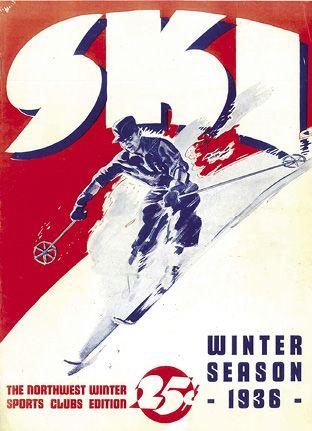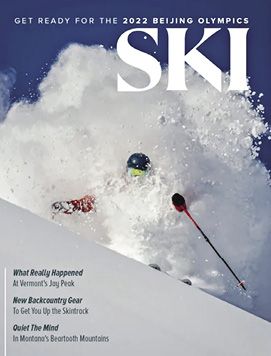
After 86 years, the magazine slashes its print run and hopes to persevere online.
After more than a decade of battling losses in subscribers and newsstand sales, SKI recently announced it will publish only one print issue a year. The magazine will continue to publish an annual print winter gear guide, but it will be a “unified” effort with its sister brands, which includes Outside and Backpacker.
In a May email to contributors, SKI editor Sierra Shafer explained that Outside Inc., owner of SKI, “made the difficult decision to reduce print by 80 percent across the company.” SKI will publish an annual print issue “for the foreseeable future,” Shafer writes. “SKI is still producing a traditional issue, our Destination Guide. Beyond that, our print plan for 2023 is still developing.”
After Skiing magazine shuttered just shy of its 70th birthday in 2017, and Powder scuttled in 2020 after nearly 50 years in print, SKI was the sport’s sole surviving mass-market publication. Before its advent, skiers read news of the sport in a variety of regional and club newsletters. The sole national publication was the American Ski Annual, published by the National Ski Association. In 1935 Seattle native Al Nydin had the idea for a national commercial magazine. The first issue of SKI appeared in January 1936, with four issues (November-February) pledged for the following season. SKI was later rebranded as Ski Illustrated and moved to New York City when World War II broke out; it was resuscitated in 1948 in Hanover, New Hampshire, by publisher William Eldred, who combined Ski Illustrated, Western Skiing and Ski News under the present title SKI. In 1962, under New York publisher Arnie Abrahamson, SKI incorporated Ski Life.

SKI published eight issues
a year for an audience of
about 450,000.
At its peak in the 1980s and 1990s, SKI published eight issues annually, including a summer issue for several years. For the 1988–89 season, a full-time editorial staff of 15 published 1,696 pages of national content, plus regional editions in the East, Midwest and West. The decline began in the mid-1990s, when readers discovered they could find more timely information, for free, on websites—including skinet.com, published by SKI and Skiing magazines, by then under the same corporate umbrella, AOL-Time Warner. Advertising revenue soon followed the audience. Like most surviving legacy media brands, SKI gradually transitioned largely to web publishing. “With a renewed focus on our digital content, we are still actively assigning and publishing work for the web,” Shafer wrote.

was largely web-based, with
just three print issues.
A long line of corporate owners fought a rear-guard battle to maintain the viability of the print edition. Most recently, Pocket Outdoor Media went on a buying spree in 2021 and acquired a handful of active lifestyle brands, including SKI, Outside and Backpacker. Pocket rebranded itself as Outside Inc. and refocused its business model with “Outside +” memberships, which provide access to content from the company’s 30-plus brands online. The monthly membership cost has recently been cut from $5 a month to $2.99 a month for the first year. Along with the decision to drastically reduce print runs companywide, Outside Inc. also announced it was laying off approximately 15 percent of its staff across all brands.
Is the party over for SKI and other print magazines? The advertising model for print seems irretrievable. The continued health of Skiing History proves that a small but devoted reading audience remains, perhaps filling the role of the original nonprofit American Ski Annual. Similarly, the quarterlies Ski Journal and Adventure Journal, along with the twice-a-year Mountain Gazette, make entertaining reading. But all charge subscription rates that allow survival without advertising support.
Aspen’s Birthplace of Skiing Preserved
Landowner deal balances development rights with protection for the Highland Bavarian Lodge

with high expectation in 1936.
Aspen Times photo.
An often-forgotten slice of Aspen’s skiing history will be preserved in a deal that gives a landowner additional development rights as a tradeoff to protect the historic site.
The Pitkin County commissioners in June approved an agreement that will preserve the Highland Bavarian Lodge and bunkhouse, the true cradle of skiing in the Aspen area. The structure will receive historic designation and be remodeled to restore its historical significance.
Property owners Meredith Loring and Sami Inkinen funded creation of a documentary film recounting the significance of the site in the development of Aspen skiing, according to coverage in the Aspen Times. The documentary will be donated to the Aspen Historical Society. A brochure on the history also will be created and a road plaque will be installed.
The Highland Bavarian Lodge was built at Ashcroft in late 1936 and opened in time to host Christmas guests. It was part of a grand vision for a ski area in the upper Castle Creek Valley (see “What Might Have Been,” March-April 2021). Ski trails were cut along the valley floor and hardier guests could ascend on climbing skins to Richmond Ridge. The owners’ grandiose plans lost momentum during World War II. After the war, development of Aspen Mountain eclipsed the Ashcroft project.
The Highland Bavarian Ranch covers 82 acres up valley from the confluence of Castle and Conundrum creeks. The property spills over to the east side of Castle Creek Road, but the owners have pledged to place a conservation easement on that section, and on 49 acres in total, the Aspen Times reported. The owners could have torn down the lodge because Pitkin County’s historic preservation program is voluntary.
As a tradeoff to the preservation of the lodge and bunkhouse, the county will grant 7,500 square feet of additional floor area for a home on the property. A home of up to 13,250 square feet can now be constructed. In addition, a density bonus was awarded for a second home of 5,750 square feet on the main ranch parcel. 
Snapshots in Time
1957 More (Not) the Merrier
To handle the army of skiing Americans that was passing last year’s record 3.5 million, slope operators were constructing luxurious lodges and higher capacity lifts, were scientifically grooming trails and putting snow on usually bare slopes. Old-line ski addicts who once welcomed the boom in the sport are now finding it a nuisance with the crowds at the slopes and inns they once had to themselves. — “NEW SLIGHTS ON SLOPES” (LIFE MAGAZINE, FEBRUARY 1957)
1968 PHONING IT IN
A new 24-hour telephone service for the latest ski reports is in operation. By dialing LY4-7500, skiers can obtain information on snow conditions in the East. The 24-hour service is supported by the New York–New Jersey American Motors Dealers Association. — “24-Hour Phone Service Offers Latest Ski Reports” (NEW YORK TIMES, DECEMBER 24, 1968)
1970 POWER PER POUND

Women racers are women, first and foremost. Very often I meet people who remark that they thought I would be much bigger. I suppose they expect us to be Amazons. Actually, the average female ski racer is the same size as the average girl. What is important is the strength per pound. This does not mean bunched muscles, either, because suppleness, gracefulness and balance are extremely important. — NANCY GREENE, “THE WOMAN RACER AS A WOMAN” (SKI MAGAZINE, JANUARY 1970)

1981 STEIN'S ADVICE
I don’t care what people say about nightlife and drinking. If you want to be on top of your skis, your mind has to be absolutely crystal clear, and you have to be in top physical condition. — STEIN ERIKSEN, INTERVIEW (POWDER MAGAZINE, JANUARY 1981)
1990 PLEASE STICK TO SKIING
The January issue of your magazine devoted six pages to snowboards and snowboarding. With all due respect to the interests of others, if I wanted a magazine about snowboards, then I would subscribe to Snowboarding Magazine, if it existed. Please stick to skiing. — DAVID R. SEGAL, REDONDO BEACH, CALIFORNIA, “NO MORE SNOWBOARDS,” LETTERS (SKIING MAGAZINE, MARCH 1990)
2003 WHERE'S THE DISCOUNT?
I’m glad you recognize that there are people over 70 who still like to ski. How about an article called “The Top Resorts for Seniors?” With the current trend of not offering free lift tickets to seniors, I would like to know which resorts still value us. After all, what we don’t spend on hefty lift ticket prices, we make up for in food, beverages and a lifetime of dedication to the industry. — JIM MORGAN, MIDLAND, MICHIGAN, “SENIORS SKI,” LETTERS (SKI MAGAZINE, MARCH-APRIL 2003)
